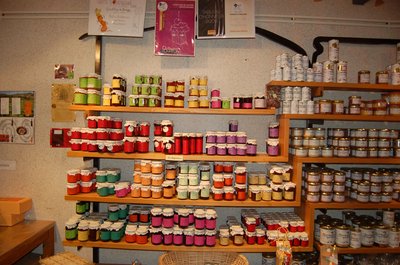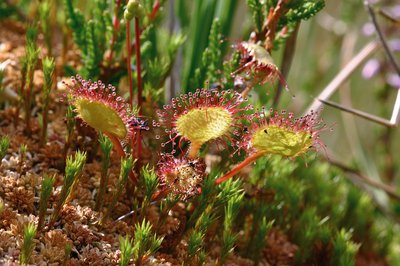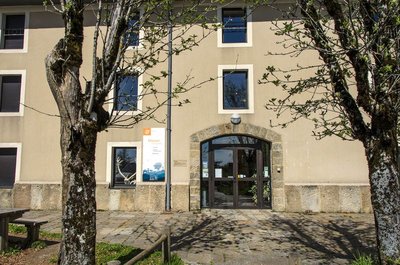
Trévezel: the botanists' and foresters' path
An extensive programme to reforest this mountain range began in 1859. It grew in scope from 1875 to 1890, under the leadership of Georges Fabre of Eaux et Forêts (Forestry Office). In parallel with this work, Charles Flahault, the director of the Montpellier Botanical Institute, carried out experiments and research on the adaption of species to local environmental conditions. This reforestation – which was to change the landscape dramatically – relied on new knowledge and was realised by foresters as well as botanists. This trail guides you in their footsteps.
10 points of interest

Maison forestière de la Serreyrède - © Jacques de Joly AgricultureLa Serreyrède
Before 1861, the house at the Col de la Serreyrède was inhabited by two families of farmers. They owned some livestock and had a vegetable garden, whose terraces you can still see above the La Caumette track. From 1861 on, the farm was inhabited by a forest ranger. It was only bought by the state body Eaux et Forêts in 1883, to be turned into a forester's house. It became one of Georges Fabre's headquarters during the reforestation of the Aigoual massif. The Cévennes National Park, tourism office and Terres d'Aigoual growers have now joined forces to revive La Serreyrède with the help of the Communauté de Communes Causses Aigoual Cévennes – Terres solidaires.

Boutique des producteurs - © Nathalie Thomas AgricultureThe association "Terres d'Aigoual"
The Cévennes National Park rents out part of the building to the association, enabling local farmers to sell their products directly to the public. The association brings together farmers who wish to promote what they produce and share their know-how. They also enjoy sharing their vision of farming- high quality produce and products,
- human-sized farms,
- mutual aid.
Come and discover their products!

 History
HistoryFrom beech copse to mature plantation
Marker 1
Around 1850, before reforestation began, the inhabitants of the Cevennes were using local wood resources on a massive scale for heating and in industry, especially spinning-mills. Gradually, only a few beech copses remained, which were cut every 25 to 40 years. Grazing by tens of thousands of sheep further reduced the herbaceous plant cover. Much weakened, the plant cover was then also subjected to heavy precipitation, the so-called Cevenol episodes. It is against this backdrop that the lengthy work of the foresters began. To reduce risks and establish a lasting forest cover, the first technique was to make use of what was already present by converting the disused copses into mature plantations.
 Know-how
Know-howProductive forest
Marker 2
Another method of creating a durable forest cover is to plant or sow. This work is carried out either on bare soil or among existing tree stands. The Aigoual reforestation programme was a gigantic effort, requiring 900,000 days of work, the planting of 60 million conifers and 7 million deciduous trees, and sowing of 38 tonnes of seeds. Spruces and pines, which can be planted in full sunlight and grow quite quickly, were widely used. Under the forest canopy, preference was given to firs.
 Natural environment
Natural environmentIrregular forest
This tree population consists of trees of very different diameters, ages and heights. Species are mixed: mainly pine, but also beech, rowan and whitebeam. This is an irregular mature forest, a forestry dynamic that is interesting for several reasons: it creates permanent forest cover; resistance to soil erosion; better resilience against storms or parasite attacks; regular production, etc. In the small clearing to the left of the path, the sunlight now penetrating to the forest floor has made natural regeneration of beech and fir possible, ensuring the renewal of the forest.

Drosera rotundifolia - © Bruno Descaves  Natural environment
Natural environmentLe Trévezel molière (peat bog)
Marker 3
A peat bog is a thick layer of plant cover that has decayed little or not at all because of accumulated water, acid soils and the cold climate. This wetland has hardly changed for centuries. Once called molières, soulages, sagnes or fanga, these environments were long denigrated and “cleaned up”. Today, they are known to be well worth preserving. Peat bogs are home to a great variety of more or less specific species, such as the sundew, a little carnivorous plant.
Pic noir mâle - © Jean-Pierre Malafosse  History
HistoryPeat bog and acclimatisation garden
Marker 4
This peat bog was a site for experiments and research by Charles Flahault. Flahault, who studied the geographical distribution of species, was interested in what was then known as acclimatisation (adaptiaton to local environmental conditions). He attempted to introduce 200 plants from 40 non-indigenous species to Le Trévezel peat bog, echoing the way tree species were introduced into arboretums. The peat bog's history and the way it works are described in detail on the panel (in French only).
 Fauna
FaunaWoodpecker nesting chambers
Marker 5
If you look up, you will see two oval holes on the beech trunks. They are black-woodpecker nesting chambers. This jet black bird with its red “beret” is the largest of Europe's woodpeckers, and rather timid. Its diet consists of ants and insects living in wood. Its prowess at hammering and digging seems quite out of proportion to its size. The opening you see gives onto a chamber with a volume of about 30 litres, which a woodpecker has dug out of healthy wood, using only its bill as a tool, over two to three weeks. In May, there will be 3 to 5 eggs in a nesting chamber. Since the number of trees with nesting chambers is limited, they have been marked with a triangle or banded in yellow to make sure that they are preserved.
 History
HistoryMulti-purpose forest
Marker 6
A draille is a path between winter and summer pastures, used by shepherds and their sheep. In the mid-19th century, this draille was the eastern border of the Miquel woods. At the time, forest covered 20 to 25% of the surface of Mont Aigoual. Following reforestation, that figure has risen to 80%. Foresters ascribe three purposes to forest: being a space the public can enjoy, providing protection and being productive. These objectives were already part of Georges Fabre's vision.
 History
HistoryGeorges Fabre
A graduate of the Ecole polytechnique, and top of his year at the Nancy forestry school, the forester Georges Fabre devoted 30 years of his energy to reforesting the mountains of the Lozère and Gard. His goal was to stabilise mountain soils, but also to provide work for a local population that would otherwise have been condemned, in its entirety, to leave the countryside. In 1894, he initiated the construction of the Mont Aigoual weather observatory. In association with the Club Cévenol and Club Alpin Français, he also laid the foundations of the local “heritage tourism” (creating the Grand Hotel de l'Aigoual, building a shelter and viewpoint indicator at the summit, etc.) that continues to this day.
Forecast
Altimetric profile
Recommandations
Information desks
Tourism & national parc'house
Col de la Serreyrède, 30570 Val d'Aigoual
The Maison de l'Aigoual houses the tourism office Mont Aigoual Causses Cévennes and the Maison du Parc national. This visitor centre provides information on and raises awareness of the Cévennes National Park, its sites and events as well as the rules that must be observed in the National Park's central zone.
On site: changing exhibitions, video projections, Festival Nature events and shop Open year-round
Transport
liO est le Service Public Occitanie Transports de la Région Occitanie/Pyrénées-Méditerranée. Il permet à chacun de se déplacer facilement en privilégiant les transports en commun.
https://lio.laregion.fr/
Access and parking
Col de la Serreyrède pass, on the D 986 Camprieu - Valleraugue or on the D 48 from Le Vigan
Parking :
Calculateur d'itinéraire Lio
Utilisez le calculateur liO pour organiser votre trajet en région Occitanie.
Autres régions
Calculez votre itinéraire en Auvergne Rhône Alpes sur Oùra
Accessibility
- Emergency number :
- 114
Biodiversité autour de l'itinéraire
Source

Report a problem or an error
If you have found an error on this page or if you have noticed any problems during your hike, please report them to us here:


